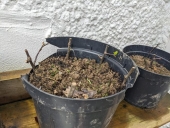
 1
1




 2
2




I make a Maple Syrup instructional movie! Check it out HERE
SKIP books, get 'em while they're hot!!! Skills to Inherit Property
See me in a movie building a massive wood staircase:Low Tech Lab Movie
 2
2




"When the whole world is running towards a cliff, he who is running in the opposite direction appears to have lost his mind." C.S. Lewis
Visit https://themaineingredient.com for organic, premium dried culinary herbs that are grown, processed, and packaged in the USA.
 2
2




John Daley Bendigo, Australia The Enemy of progress is the hope of a perfect plan
Benefits of rainfall collection https://permies.com/t/88043/benefits-rainfall-collection
GOOD DEBT/ BAD DEBT https://permies.com/t/179218/mortgages-good-debt-bad-debt
 1
1




 2
2




andCob walling was always constructed from a stone plinth….although [I hear] there have been written commentaries suggesting that some cob walls were built straight off of the ground. (Needless to say, that there may not be any surviving examples of this fashion).
... Whatever the height of the plinth, its primary purpose is to ensure that the base of the cob wall is suitably distanced from ground-level in order to prevent inevitable saturation and certain collapse.
"When the whole world is running towards a cliff, he who is running in the opposite direction appears to have lost his mind." C.S. Lewis
Visit https://themaineingredient.com for organic, premium dried culinary herbs that are grown, processed, and packaged in the USA.
 1
1




"When the whole world is running towards a cliff, he who is running in the opposite direction appears to have lost his mind." C.S. Lewis
Visit https://themaineingredient.com for organic, premium dried culinary herbs that are grown, processed, and packaged in the USA.




John Daley Bendigo, Australia The Enemy of progress is the hope of a perfect plan
Benefits of rainfall collection https://permies.com/t/88043/benefits-rainfall-collection
GOOD DEBT/ BAD DEBT https://permies.com/t/179218/mortgages-good-debt-bad-debt












If there is one thing the Wizard of Oz has taught me, it is not to trust school teachers on bicycles.




If there is one thing the Wizard of Oz has taught me, it is not to trust school teachers on bicycles.





|
We're being followed by intergalactic spies! Quick! Take this tiny ad!
Rocket Mass Heater Resources Wiki
https://permies.com/w/rmh-resources
|



